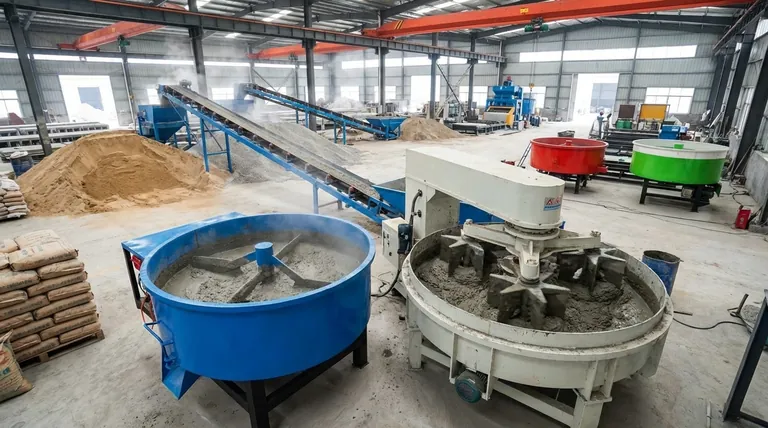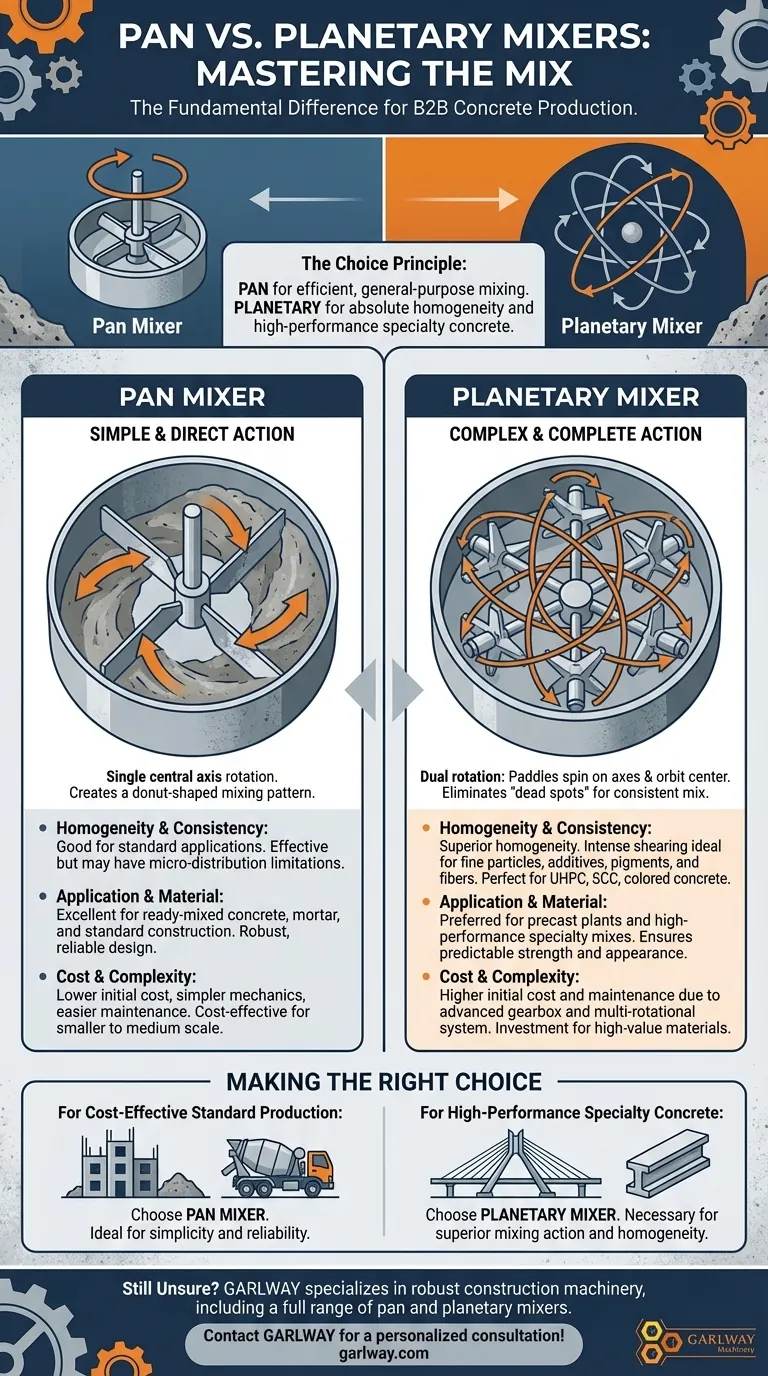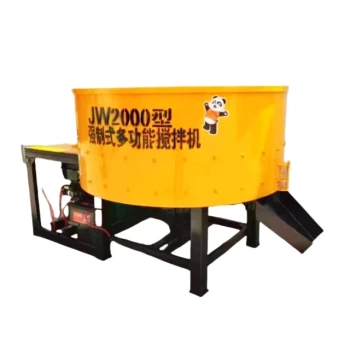The fundamental difference between pan and planetary mixers lies in their mixing action. A pan mixer uses a simple, circular motion with blades revolving around a single central axis, while a planetary mixer employs a more complex, dual-rotation action where paddles spin on their own axes while also revolving around the center of the mixing pan. This key mechanical difference makes planetary mixers more thorough, serving specialized applications.
While both are stationary-pan mixers used for concrete, the choice between them comes down to a simple principle: pan mixers are for efficient, general-purpose mixing, whereas planetary mixers are for achieving the absolute homogeneity required for high-performance and specialty concrete.

Deconstructing the Mixing Action
To understand which mixer is right for your needs, you must first visualize how each one works. The distinction is in the movement and coverage of the mixing arms.
The Pan Mixer: Simple and Direct
A pan mixer operates on a straightforward principle. It consists of a static, cylindrical pan and a set of mixing arms or blades that rotate around a central, vertical shaft.
The blades are angled to continuously lift, fold, and shear the material against the pan's floor and walls. This creates an effective, donut-shaped mixing pattern that is well-suited for many standard concrete applications.
The Planetary Mixer: Complex and Complete
A planetary mixer elevates the mixing process. It features one or more mixing "stars" or paddles that rotate on their own individual axes. Crucially, this entire assembly also revolves around a central point within the pan.
Think of the Earth spinning on its axis while simultaneously orbiting the Sun. This compound motion is incredibly forceful and ensures the paddles cover every point within the pan multiple times per revolution. This eliminates "dead spots" and guarantees an exceptionally consistent and homogeneous mix.
Why the Mixing Action Matters
The difference in mechanical action has direct consequences on the quality, speed, and application of the concrete being produced.
Homogeneity and Consistency
Planetary mixers produce a superior level of homogeneity. The intense, shearing action is ideal for thoroughly distributing fine particles, additives, pigments, and fibers throughout a mix.
This is essential for specialty concretes like Ultra-High Performance Concrete (UHPC), Self-Consolidating Concrete (SCC), or architecturally colored concrete where absolute consistency is paramount. Pan mixers are effective, but may not achieve the same level of micro-distribution.
Application and Material Type
Pan mixers are excellent workhorses for producing ready-mixed concrete, mortar, and other general-purpose materials. Their robust and simpler design makes them a reliable choice for standard construction projects.
Planetary mixers are the preferred choice for precast concrete plants and projects requiring special mixes. As noted in industry practice, their ability to create a perfectly uniform batch is critical for producing high-quality finished products with predictable strength and appearance.
Understanding the Trade-offs
Choosing between these mixers isn't just about mixing quality; it's also a practical decision involving cost and complexity.
Cost and Mechanical Complexity
The advanced gearbox and multi-rotational system make planetary mixers significantly more expensive to purchase and maintain than pan mixers. The mechanical complexity is higher, requiring more specialized upkeep.
Batch Capacity and Scale
While both types are available in various sizes, pan mixers are often a cost-effective solution for smaller batches or less demanding production environments. Planetary mixers represent a larger investment typically justified by the high-value materials they produce in demanding, industrial settings like precast factories.
Making the Right Choice for Your Application
Your final decision should be guided entirely by the performance requirements of your concrete.
- If your primary focus is cost-effective production of standard ready-mix or mortar: The simplicity and reliability of a pan mixer make it the ideal choice.
- If your primary focus is producing high-performance, precast, or specialty concrete: The superior mixing action and homogeneity of a planetary mixer is a necessary investment.
Ultimately, selecting the right mixer is about matching the tool's capability to the demands of the final product.
Summary Table:
| Feature | Pan Mixer | Planetary Mixer |
|---|---|---|
| Mixing Action | Blades rotate around a single central axis. | Paddles rotate on their own axes AND revolve around the pan's center. |
| Best For | Cost-effective, general-purpose concrete (e.g., ready-mix, mortar). | High-performance, specialty concrete (e.g., UHPC, precast, colored concrete). |
| Homogeneity | Good for standard applications. | Superior; eliminates dead spots for absolute consistency. |
| Cost & Complexity | Lower cost, simpler mechanics, easier maintenance. | Higher initial cost and maintenance due to complex gearbox. |
Still Unsure Which Mixer is Right for Your Project?
GARLWAY specializes in providing robust construction machinery, including a full range of pan mixers and planetary mixers, designed to meet the specific demands of construction companies and contractors globally.
Let our experts help you select the perfect equipment to ensure the quality, efficiency, and profitability of your concrete production.
Contact GARLWAY today for a personalized consultation and discover the right mixer for your application!
Visual Guide

Related Products
- Ready Mixer Machine for Construction Ready Mix Machinery
- Concrete Cement Mixer Machine Drum Mixer for Construction
- JZC1000 Industrial Concrete Mixer Machine Cement Mixer Price
- Commercial Construction Mixer Machine for Soil Cement Mixing Concrete
- Hydraulic Concrete Mixer Machine Cement Mixing Equipment for Mixture Concrete
People Also Ask
- Why is the manufacturer's strength and service important when choosing a concrete mixer? Ensure Long-Term Project Success
- What is the average lifespan of a concrete mixer? Maximize Your Equipment's Lifespan & ROI
- When was the first concrete mixer developed and by whom? Discover the 1900 Breakthrough
- What safety considerations are important for concrete mixer operation? A Guide to Proactive Risk Management
- Can a concrete mixer be used for mortar? Understanding the trade-offs for your project



















